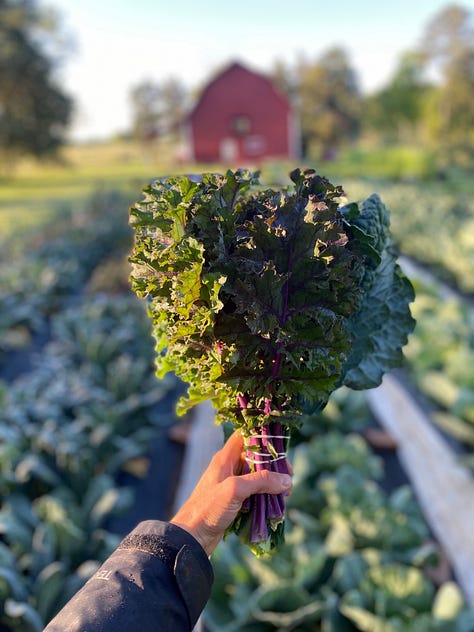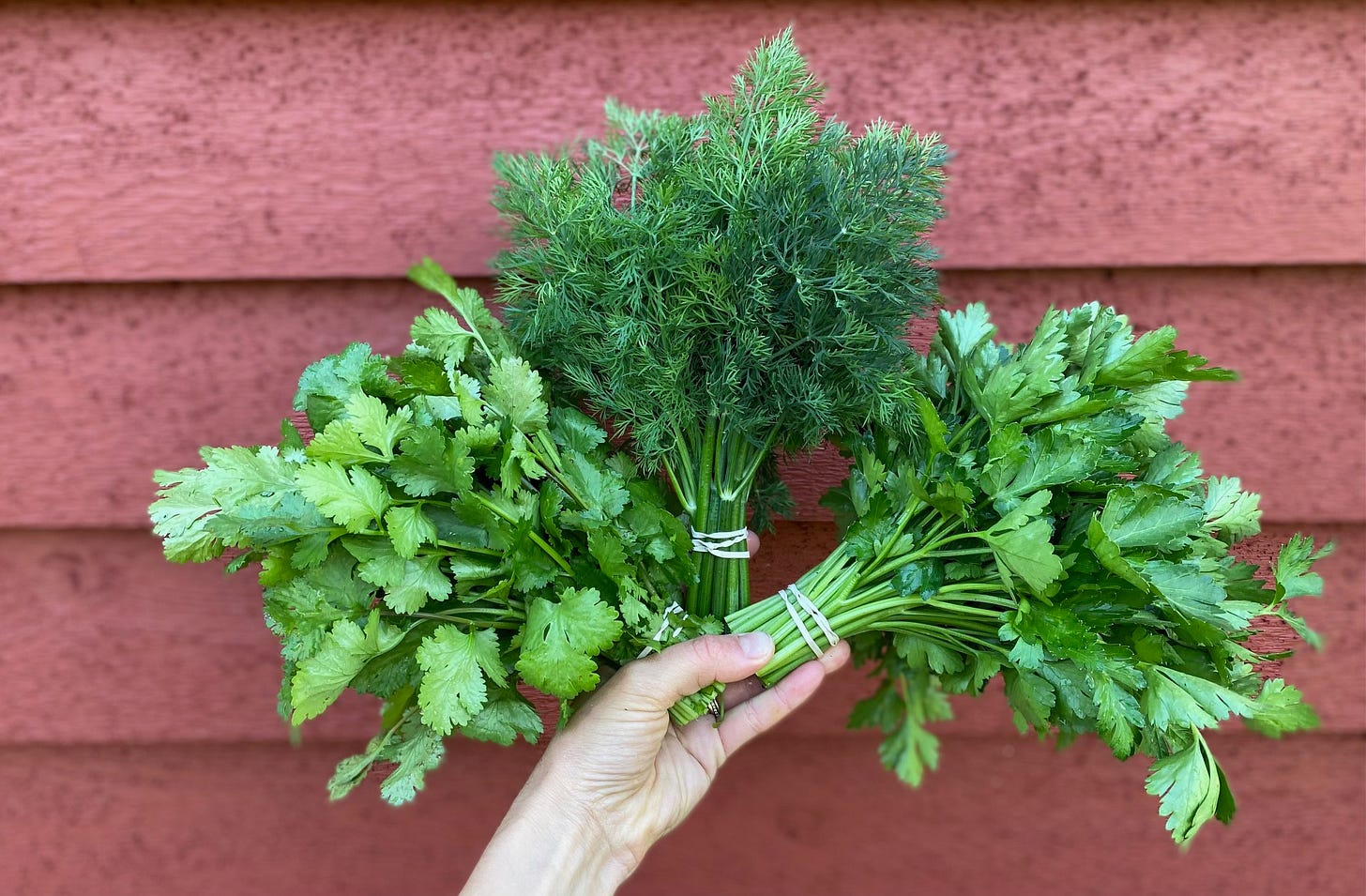Hot dang, it’s been a whirlwind week around here… what day is it again?
Last week we snuck away to the beach for a quick rest + reset with family, which was soul-filling and a literal breath of fresh air. (Though, I will say, I’m quickly learning that a “vacation” with a toddler in tow isn’t exactly a vacation… more like, parenting! but in a different location! So while I didn’t exactly catch up on sleep, I did get some quality time in the sun + sand with the fam, which is just what I needed).
The only bummer about leaving the farm for several days? Coming back to the farm is pretty overwhelming. We have amazing neighbors who took great care of our chickens and plants while we were away, but all the grass and weeds can’t stop won’t stop, and it seemed like everything grew a foot in the few days we were gone.
Alas. Over the past week, we’ve worked hard to reign in the chaos, and our Tuesday CSA went off without a hitch. SO many gorgeous veggies are coming out of the fields right now… from lettuces to radishes, kale, broccoli, kohlrabi, beets, fennel, herbs, etc etc. I may be short on sleep, but I’m rich in spring greens. :)



In addition to keeping up with all the grass + weeds and pulling off Week 4 of our Spring CSA, this week we also planted (and pruned and trellised) a TON more tomatoes, and we’re busy prepping beds to plant heaps of summer peppers, eggplant, zucchini, and cucumbers. Oh, and yesterday I taught a Growing & Cooking with Herbs workshop here at the farm, and this morning I led a culinary lesson with a dozen preschoolers, where we whipped up veggie kabobs and homemade ranch dip.
Basically, what I’m trying to say is that I need a nap.
Which is pretty par for the course for a farmer in North Carolina in late April. But amidst all the chaos, I am wildly grateful for this season of growth and abundance, which we’ve been working towards all winter/early spring, and I’m so thankful for all the friends and neighbors and family members who help keep this tired farmer and our little farm chugging along.
Okay, enough chit chat, it’s time to get cooking!
This week I’m digging into all things herbs, and I’m sharing my recipe for homemade herb salt, which will rock your world.
PS – CONGRATS Alison Fox! You are the winner of our April giveaway (which is open to all my fabulous paid subscribers), and you’ll be receiving a jar of my Farmbelly Tuscan Herb Salt as a thank you for your support. :)
Fresh herbs are one of my favorite things to grow AND cook with, but for some reason, they usually don’t get the credit they’re due. Herbs are super easy to grow (even if you only have space for a few pots) and they add such a unique and refreshing depth of flavor to dishes, and I’m all about incorporating more herby goodness into pretty much everything.
So let’s get into it.
Below I’m answering a few of the most common questions I get about herbs, and then you can keep scrolling for today’s recipe for homemade herb salt, which is one of the best ways to preserve an abundance of fresh herbs.
1) What’s the difference between an herb and a spice?
Both herbs and spices are parts of plants used to season and add flavor to food:
Herbs are the leaves of the plant
Spices come from the roots, bark, and seeds (ex: cinnamon, coriander seeds, etc)
2) When should I cook with *dried* herbs?
Use dried herbs at the beginning and during cooking, especially when making soups, stews and sauces (aka dishes where you are building lots of flavor over time, usually over heat)
Hardy herbs like oregano, rosemary, and thyme are able to retain their flavor through the drying process, and they translate best to being dried. This means that tender herbs like basil *probably* aren’t best to use dried, and most likely if you see basil in a recipe, it’s meant to be used when fresh.
3) When should I cook with *fresh* herbs?
Fresh herbs are more delicate than dried herbs, so use them at the end of cooking as a garnish (like ribbons of fresh basil on some delicious margherita pizza, hot out of the oven).
Fresh herbs are also best used in dishes that don’t require any heat, such as pestos/simple sauces, added to fresh salads, etc.
4) How do I store *fresh* herbs so they don’t go bad?
There are two main ways I store fresh herbs, and the method to use depends on the type of herb you want to store:
For tender, leafy herbs (like parsley, cilantro, dill, basil) store by placing the stems in a jar of water and leave it out on your counter. Refresh the water when it gets low and/or murky, and you can also give the herb stems a fresh cut with a knife to encourage them to take up more water. I like to have the jar out on my counter because a) the herbs smell and look lovely, and b) I’m way less likely to forget about them!
For hardier herbs (like rosemary, thyme, sage) store by wrapping the herbs in a damp paper towel, then put them inside a plastic bag, and into your refrigerator. This method should keep your hardy herbs fresh for up to 2 weeks.
Another delishhh way to preserve herbs? Make herb salt! DIY herb salt couldn’t be easier, and it’s a great way to preserve your fresh herbs when they are in abundance.
When do you even use herb salt? Anywhere that you would normally use salt – so use it for seasoning meat, veggies, vinaigrettes, eggs, literally anything. (My absolute favorite is making basil salt to season super ripe, juicy summer tomatoes. YUM.) Keep reading for the full recipe.
HOMEMADE HERB SALT
INGREDIENTS









